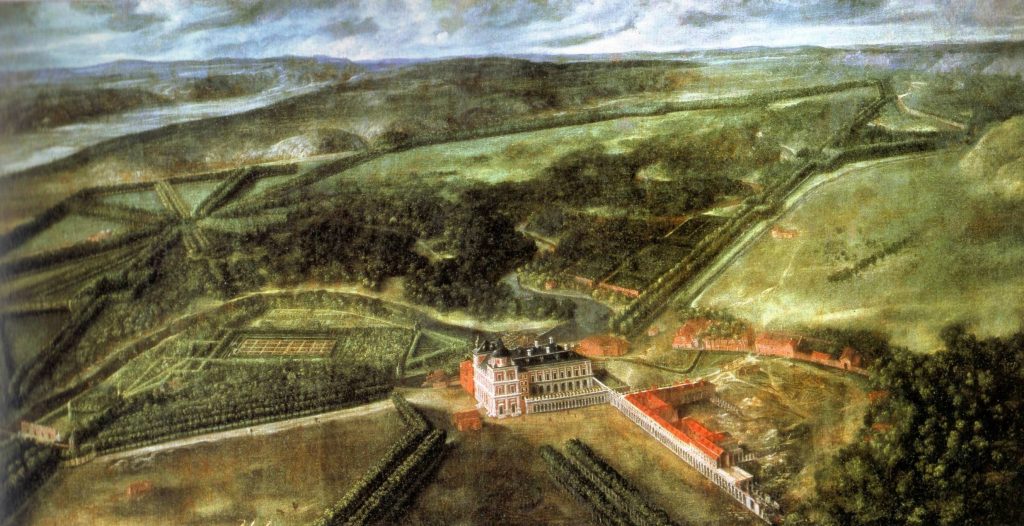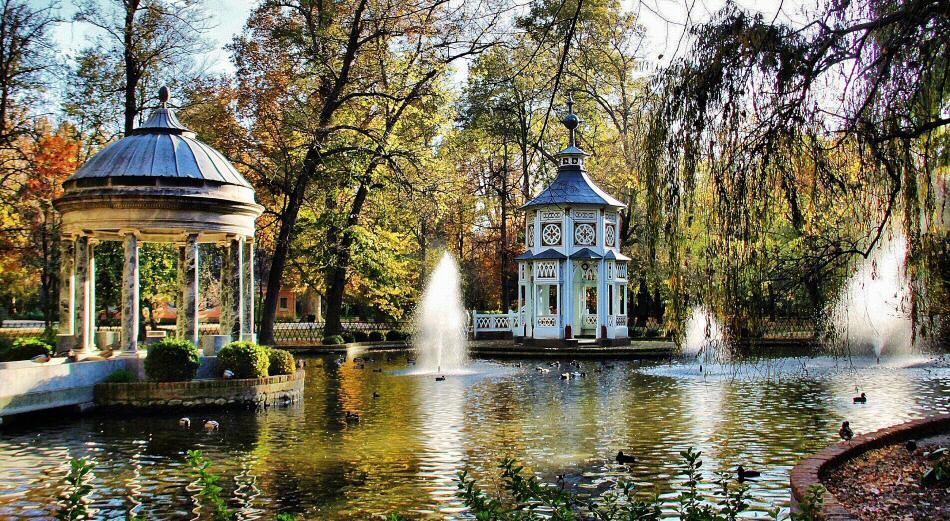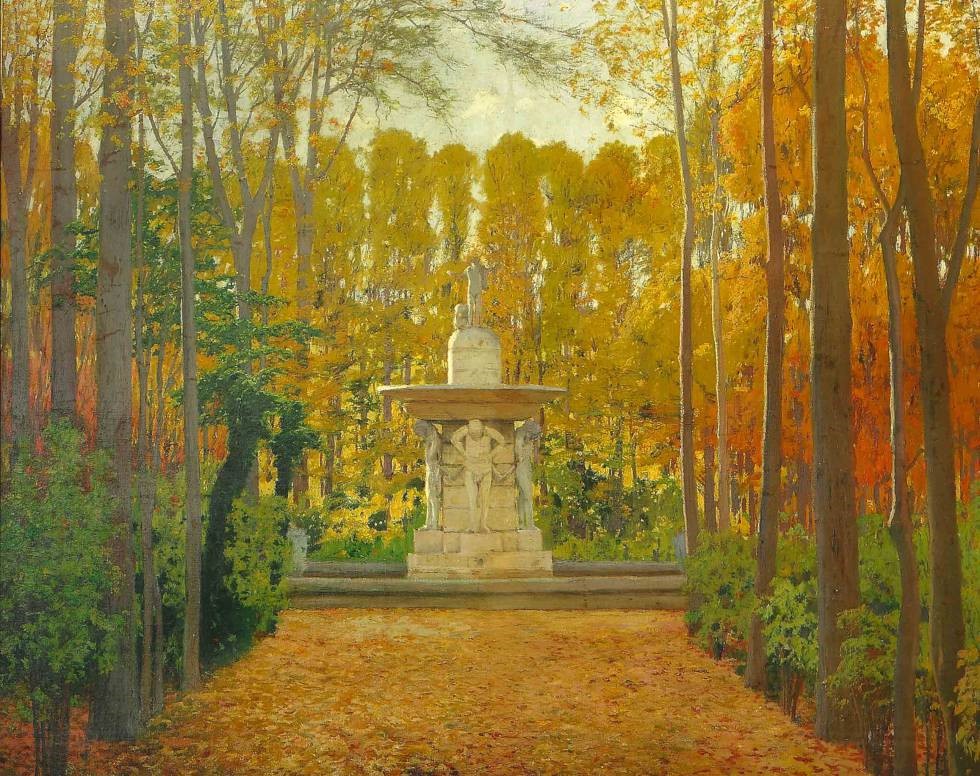 Do you want to read in English? Click here
Do you want to read in English? Click here
 LOCALIZACIÓN
LOCALIZACIÓN
En la zona más meridional de la Comunidad de Madrid, en la confluencia de los ríos Tajo y Jarama, se sitúa el municipio de Aranjuez. Este emplazamiento de características únicas que han sido aprovechadas durante siglos, favoreció el acercamiento de la familia real española, pues era un sitio idóneo para celebrar cacerías y explotar productos en sus huertas, como las fresas y espárragos, que hoy en día siguen gozando de gran popularidad.
BREVE HISTORIA DE ARANJUEZ
Existen restos que demuestran la existencia de asentamientos desde la Prehistoria, pero no es hasta finales del siglo XII cuando comenzará a tomar mayor importancia. El primer asentamiento llegó de la mano del rey Alfonso VIII y la Orden de Santiago, motivo por el cual la cruz de Santiago aparece en el escudo de la localidad.
Ya a mediados del siglo XVI, durante el reinado de Carlos I se llevaron a cabo las primeras obras de ingeniería, y sería posteriormente su sucesor, el rey Felipe II, quien le otorgaría el título de Real Sitio además de iniciar las reformas en los jardines, comenzar el aprovechamiento agrícola de sus huertas, y encomendar el diseño y construcción del palacio real a los arquitectos Juan Bautista de Toledo y Juan de Herrera. Por aquel entonces, la residencia en la localidad estaba reservada a la Corte. Durante el reinado de Fernando VI, nace en 1752 el municipio tal y como lo conocemos hoy, pues se autorizó el libre asentamiento de pobladores. (imagen 1)
La localidad también es recordada por el año 1808, cuando en marzo, durante su famoso Motín, el rey Carlos IV abdicaría en su hijo, Fernando VII; y meses después, en septiembre, sería el lugar de reunión de la Junta Suprema Central, para planificar las acciones que debían realizarse para frenar a los invasores franceses en la Guerra de Independencia.
En 1851 se produce otro hito en la ciudad, pues se inaugura la línea de ferrocarril que unía el municipio con la capital española (esta línea se encuentra aún activa), siendo la segunda línea en abrirse al tráfico ferroviario en España, tras la que unía las ciudades de Barcelona y Mataró.
El 14 de diciembre del año 2001, la UNESCO incluyó el Paisaje Cultural de Aranjuez en su lista de sitios Patrimonio de la Humanidad.
Durante todos estos siglos, se ha ido conformando un entorno único formado por la simbiosis del ser humano junto con la naturaleza que combina elementos arquitectónicos, reflejados en el Palacio, fuentes, y demás monumentos; urbanísticos, como el trazado de sus paseos y el trazado ortogonal de la Ciudad Ilustrada; culturales e intangibles, siendo inspiración para pintores, músicos y escritores; y por último paisajísticos, como los jardines, sotos, huertas, y el propio río Tajo.
ARANJUEZ PAISAJE CULTURAL
Con la influencia de la Corona y la riqueza natural como elementos determinantes, los primeros pasos del Paisaje Cultural los dio el rey Felipe II con su declaración de Aranjuez como Real Sitio. Durante el siglo XX, se produce una evolución desde un uso privado de la Corona hacia una apertura para el disfrute universal.
Por todos estos motivos, la UNESCO avaló la declaración de Aranjuez sobre los criterios número II (testimonio del intercambio y confluencia de distintos valores, manifestaciones y corrientes cultura cuya asimilación intelectual y recreación da lugar a un Paisaje Cultural que, a su vez, constituye un hito referencial e influyente en la conformación de posteriores creaciones de este tipo) y número IV (materialización y combinación de obras paisajísticas, arquitectónicas y artísticas representativas de períodos clave de la historia de la humanidad y prototípicas de manifestaciones posteriores en las que se aúnan las relaciones entre el hombre y la naturaleza).
Para seguir subrayando la incalculable singularidad del lugar y esta combinación de elementos, podemos destacar la influencia flamenca en la ordenación territorial, fruto de los viajes y de los conocimientos que en ellos adquiere Felipe II; la influencia francesa y anglochina en los jardines, o la plasmación del barroco y neoclásico puramente teóricos en el culto a las ruinas y a la Antigüedad.
Dicha combinación dan lugar a unos “subpaisajes” dentro del Paisaje Cultural: paisaje del agua, agropecuario, los jardines, el paisaje ordenado y el paisaje construido.
- Paisaje del agua: producto de los ríos Tajo y Jarama son los estanques, presas, canales y puentes que Felipe II ordenó construir. Todo ello posee una función práctica, estética, de ocio (las fuentes) y simbólica. (imagen 2)
- Huertas y sotos: prados, casas de cría y viveros plasman la variedad de especies y los experimentos agrícolas. Desde el siglo XVI hasta nuestros días esto se ha mantenido, siendo uno de los pilares de la economía arancetana, y lugar de cultivo de dos de los iconos locales y representantes de la gastronomía, el famoso fresón de Aranjuez y los espárragos.
- Los jardines: el deleite y el ocio. Con características de jardines de todo el mundo y de todas las épocas, poseen una variedad botánica que conjuga la colección de especies exóticas con la aclimatación y la experimentación científica. (imagen 3)
- La geometría, plasmada sobre los planos de la ciudad y de la zona agraria. Está integrada en las calles y plazas, el espacio urbano y el sistema hidráulico.
- Y por último, el paisaje construido reflejado en el Palacio Real, piedra angular del lugar, que desde el siglo XVI ha sido el elemento generador de la forma del espacio paisajístico; la Ciudad Barroca del siglo XVIII, y la ciudad rústica, como la pedanía del Real Cortijo de San Isidro también forman parte de este paisaje. (imagen 4)
A todo esto hay que añadirle lo intangible, un patrimonio que en ocasiones es pasado por alto, pero que sin él, Aranjuez no sería lo que es hoy. A las tradiciones y folclore local, como la recreación anual del Motín de Aranjuez, se le añaden las figuras artísticas de Santiago Rusiñol, pintor que encontró una fuente de explotación para su obra en la localidad de Aranjuez y sus jardines; José Luis Sampedro, con su novela “El río que nos lleva” inspirada en el Tajo y sus gancheros; y el maestro Joaquín Rodrigo, que inspirado por Aranjuez, dejó fluir su virtuosismo plasmándolo en los pentagramas del mundialmente conocido “Concierto de Aranjuez”. (imagen 5)
¿CÓMO PODEMOS PROTEGER Y EXPLOTAR TURÍSTICAMENTE DE MANERA SOSTENIBLE EL PAISAJE CULTURAL DE ARANJUEZ?
Teórica y legislativamente es una responsabilidad que en primer lugar recae sobre las administraciones estatal, comunitaria y local. El sistema de protección se sostiene sobre una base jurídica que garantiza la salvaguarda de los elementos singulares del territorio, como lo son la declaración de Conjunto Histórico y el Plan General de Ordenación Urbana para el desarrollo arquitectónico de manera armónica y respetuosa. Además, alrededor del espacio declarado existe un área de protección o tampón, que coincide con la totalidad del municipio de Aranjuez. (imagen 6)
Sin embargo, a pie de calle, a esta realidad se le ha de sumar otra, pues es esencial para la conservación de Aranjuez la labor del ciudadano y de las comunidades locales. La cooperación y trabajo en conjunto de estos agentes son clave en la concienciación y en la explotación sostenible de todos los recursos de los que dispone Aranjuez, lo cual conducirá al desarrollo y a la conservación óptima de un patrimonio que pese a que legislativamente es propiedad de los órganos de gobierno, en realidad es propiedad y responsabilidad de una comunidad más grande en la que nos incluimos todos.
-

Aranjuez durante el reinado de Felipe II / Aranjuez during Phillip’s II reign -

Fuentes de Aranjuez / Aranjuez’s Fountains -

Chinescos de Jardín del Príncipe / Prince’s Garden Chinescos -

Palacio Real / Royal Palace -

: Fuente de Narciso (1906), Santiago Rusiñol / Narciso’s Fountain (1906), Santiago Rusiñol -

Vista aérea de Aranjuez/Aerial view of Aranjuez
 LOCATION
LOCATION
Aranjuez is located in the South of the Autonomous Community of Madrid, at the confluence of the Tagus and Jarama rivers. This site of unique characteristics that have been exploited throughout centuries encouraged the approaching of the Spanish royalty, since it was an ideal place for hunting and exploiting the products of the orchards, such as strawberries and asparagus, which nowadays still grow in Aranjuez.
BRIEF HISTORY OF ARANJUEZ
There are archaeological remains that prove the existence of settlements since the Prehistory, but it was not until the end of the twelfth century when Aranjuez started to gain some importance. The first inhabitants arrived with Alphonso VIII and the Order of Santiago, the reason why Santiago’s cross appears in the local emblem.
It was in the middle of the sixteenth century, during Charles I’s reign, when the first engineering works started. Later, Phillip II awarded the town with the Royal Site title, and started the reforms of the gardens, the exploitation of the orchards; he entrusted the design and the construction of the Royal Palace to the architects Juan Bautista de Toledo and Juan de Herrera. At that time, the residence of the town was restricted to the people outside the Court. The city of Aranjuez, as we know it today, was born in 1752 during Ferdinand VI’s reign, since then free settlement of people was authorized. (image 1)
Aranjuez is also well-known for the riot of March 1808, the king Charles IV abdicated in favour of his son Ferdinand VII after the Munity of Aranjuez; and months later, in September, Aranjuez would be the meeting point for the Supreme Central Council, which started to plan the actions to stop the French starting the Independence War.
We have to highlight the construction of the Aranjuez-Madrid Railway that started working in 1851, which is still in use today. It is the second oldest railway in Spain, after Barcelona-Mataró line.
On 14 December 2001, UNESCO included Aranjuez Cultural Landscape in the World Heritage List.
Throughout this centuries, an unique site has been growing thanks to the human and natural symbiosis, mixing architectonic elements, such as the Royal Palace, fountains and monuments; urban elements, like the orthogonal pattern of the Baroque Town and the geometrical pattern of its tree-lined alleys; cultural elements, being an inspiration for painters, musicians, and writers; and landscape elements, such as the orchards, grooves, the gardens, and the Tagus River itself.
ARANJUEZ CULTURAL LANDSCAPE
With the influence of the Crown and the natural wealth as determinant elements, the first steps of the Cultural Landscape were taken by the king Phillip II with his declaration of Aranjuez as a Royal Site. In the twentieth century, the site evolved from a private use of the Crown to public enjoyment of all visitors around the world.
For that reasons, UNESCO endorsed the declaration of Aranjuez on the criteria II (to exhibit an important interchange of human values, over a span of time or within a cultural area of the world, on developments in architecture or technology, monumental arts, town-planning or landscape design) and criteria IV (to be an outstanding example of a type of building, architectural or technological ensemble or landscape which illustrates significant stages in human history).
To continue highlighting the invaluable singularity of the site and this combination of elements, we can emphasize the Flemish influence on the land management, as a result of Phillip II’s travels; and also the French and Anglo-Chinese influence on the gardens, or the embodiment of a purely theoretical Baroque and Neoclassic in the cult to ruins and to Antiquity.
The before mentioned combination gives rise to five “sub-landscapes” inside the Cultural Landscape: landscape of the water, agricultural landscape, the gardens, the organized landscape and the built landscape.
- Landscape of the water: product of the Tagus and Jarama rivers are the ponds, dams, channels and bridges built under the orders of Phillip II. All of that has a practical, aesthetical, leisure (fountains), and symbolical function. (image 2)
- Orchards and grooves: meadows, breeding farms and plant nurseries embodies the variety of species and the agricultural experiments. This has been kept from sixteenth century to now, being one of the pillars of the local economy, and cultivation place of two of the local icons and milestones of the gastronomy, the famous strawberries of Aranjuez and its asparagus.
- The gardens: delight and leisure. With characteristics from all around the world gardens, and from all periods, the gardens have a botanic variety that conjugate the collection of exotic plants with the acclimatization and scientific experimentation. (image 3)
- The geometry, depicted on the maps of the city and the agricultural zone. It is integrated in the streets and squares, the urban space and the hydraulic system.
- And, finally, the built landscape reflected in the Royal Palace, cornerstone of Aranjuez. Since sixteenth century, it has been the generating element of the shape of the landscape. The Baroque Town of the eighteenth century, and the rustic town, such as Real Cortijo de San Isidro, also conforms this landscape. (image 4)
To all of these, we have to add the intangible heritage that sometimes is forgotten, but without it, Aranjuez would not be what it is today. In addition to traditions and local folklore, such as the yearly recreation of the Munity of Aranjuez, we find the artistic figures of Santiago Rusiñol, a painter who found his inspiration source in Aranjuez and its gardens; José Luis Sampedro, writer of the novel “El río que nos lleva”, based in the Tagus river and its “gancheros”; and maestro Joaquín Rodrigo, who inspired by Aranjuez, embodied his virtuosity in the pentagrams of the world wide known “Concierto de Aranjuez”. (image 5)
HOW CAN WE SHOW ARANJUEZ TO TOURISTS IN A SUSTAINABLE WAY WHILE PRESENTING IT?
Theoretically and by law protection of heritage is a number one priority that firstly lays on State, then the Autonomous Communities and the Local Administrations. The protection system is held by legal basis that assure the safeguarding of the singular elements of the territory, like the declaration as Historical Site and the General Urban Plan for the architectonic development in a harmonious and friendly way. Besides, there is a protection area around the core area, which corresponds with the whole municipality of Aranjuez. (image 6)
However, there is another reality added to the last mentioned, since local people and communities efforts are essential for Aranjuez conservation. Cooperation and partnership work are key factors in the awareness of locals and the sustainable exploitation of all the resources of the town, that will drive to optimal development and conservation of a heritage which is a property and a responsibility for a the community including the Administrative bodies.

